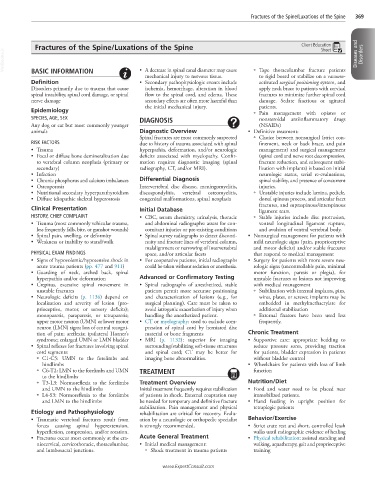Page 780 - Cote clinical veterinary advisor dogs and cats 4th
P. 780
Fractures of the Spine/Luxations of the Spine 369
Fractures of the Spine/Luxations of the Spine Client Education
Sheet
VetBooks.ir Diseases and Disorders
• A decrease in spinal canal diameter may cause
BASIC INFORMATION
to rigid board or stabilize on a vacuum-
mechanical injury to nervous tissue. ○ Tape thoracolumbar fracture patients
Definition • Secondary pathophysiologic events include activated surgical positioning system, and
Disorders primarily due to trauma that cause ischemia, hemorrhage, alteration in blood apply neck brace to patients with cervical
spinal instability, spinal cord damage, or spinal flow to the spinal cord, and edema. These fractures to minimize further spinal cord
nerve damage secondary effects are often more harmful than damage. Sedate fractious or agitated
the initial mechanical injury. patients.
Epidemiology ○ Pain management with opiates or
SPECIES, AGE, SEX DIAGNOSIS nonsteroidal antiinflammatory drugs
Any dog or cat but most commonly younger (NSAIDs)
animals Diagnostic Overview • Definitive treatment:
Spinal fractures are most commonly suspected ○ Choice between nonsurgical (strict con-
RISK FACTORS due to history of trauma associated with spinal finement, neck or back brace, and pain
• Trauma hyperpathia, deformation, and/or neurologic management) and surgical management
• Focal or diffuse bone demineralization due deficits associated with myelopathy. Confir- (spinal cord and nerve root decompression,
to vertebral column neoplasia (primary or mation requires diagnostic imaging (spinal fracture reduction, and subsequent stabi-
secondary) radiography, CT, and/or MRI). lization with implants) is based on initial
• Infection neurologic status, serial re-evaluations,
• Chronic phosphorus and calcium imbalances Differential Diagnosis spinal stability, and presence of concurrent
• Osteoporosis Intervertebral disc disease, meningomyelitis, injuries.
• Nutritional secondary hyperparathyroidism discospondylitis, vertebral osteomyelitis, ○ Unstable injuries include lamina, pedicle,
• Diffuse idiopathic skeletal hyperostosis congenital malformations, spinal neoplasia dorsal spinous process, and articular facet
fractures, and supraspinous/interspinous
Clinical Presentation Initial Database ligament tears.
HISTORY, CHIEF COMPLAINT • CBC, serum chemistry, urinalysis, thoracic ○ Stable injuries include disc protrusion,
• Trauma (most commonly vehicular trauma, and abdominal radiographs: assess for con- ventral longitudinal ligament rupture,
less frequently falls, bite, or gunshot wounds) comitant injuries or pre-existing conditions and avulsion of ventral vertebral body.
• Spinal pain, swelling, or deformity • Spinal survey radiographs to detect disconti- • Nonsurgical management for patients with
• Weakness or inability to stand/walk nuity and fracture lines of vertebral column, mild neurologic signs (pain, proprioceptive
malalignment or narrowing of intervertebral and motor deficits) and/or stable fractures
PHYSICAL EXAM FINDINGS space, and/or articular facets that respond to medical management
• Signs of hypovolemic/hypotensive shock in • For cooperative patients, initial radiographs • Surgery for patients with more severe neu-
acute trauma patients (pp. 477 and 911) could be taken without sedation or anesthesia. rologic signs (uncontrollable pain, minimal
• Guarding of neck, arched back, spinal motor function, paresis or plegia), for
hyperpathia and/or deformation Advanced or Confirmatory Testing unstable fractures or lesions not improving
• Crepitus, excessive spinal movement in • Spinal radiographs of anesthetized, stable with medical management
unstable fractures patients permit more accurate positioning ○ Stabilization with internal implants, pins,
• Neurologic deficits (p. 1136) depend on and characterization of lesions (e.g., for wires, plates, or screws; implants may be
localization and severity of lesion (pro- surgical planning). Care must be taken to embedded in methylmethacrylate for
prioceptive, motor, or sensory deficits); avoid iatrogenic exacerbation of injury when additional stabilization
monoparesis, paraparesis, or tetraparesis; handling the anesthetized patient. ○ External fixators have been used less
upper motor neuron (UMN) or lower motor • CT or myelography: used to exclude com- frequently.
neuron (LMN) signs; loss of central recogni- pression of spinal cord by herniated disc
tion of pain; areflexia; ipsilateral Horner’s material or bone fragments Chronic Treatment
syndrome; enlarged UMN or LMN bladder • MRI (p. 1132): superior for imaging • Supportive care: appropriate bedding to
• Spinal reflexes for fractures involving spinal surrounding/stabilizing soft-tissue structures reduce pressure sores, providing traction
cord segments: and spinal cord; CT may be better for for patients, bladder expression in patients
○ C1-C5: UMN to the forelimbs and imaging bone abnormalities. without bladder control
hindlimbs • Wheelchairs for patients with loss of limb
○ C6-T2: LMN to the forelimbs and UMN TREATMENT function
to the hindlimbs
○ T3-L3: Normoreflexia to the forelimbs Treatment Overview Nutrition/Diet
and UMN to the hindlimbs Initial treatment frequently requires stabilization • Food and water need to be placed near
○ L4-S3: Normoreflexia to the forelimbs of patients in shock. External coaptation may immobilized patients.
and LMN to the hindlimbs be needed for temporary and definitive fracture • Hand feeding in upright position for
stabilization. Pain management and physical tetraplegic patients
Etiology and Pathophysiology rehabilitation are critical for recovery. Evalu-
• Traumatic vertebral fractures result from ation by a neurologic or orthopedic specialist Behavior/Exercise
forces causing spinal hyperextension, is strongly recommended. • Strict crate rest and short, controlled leash
hyperflexion, compression, and/or rotation. walks until radiographic evidence of healing
• Fractures occur most commonly at the cra- Acute General Treatment • Physical rehabilitation: assisted standing and
niocervical, cervicothoracic, thoracolumbar, • Initial medical management: walking, aquatherapy, gait and proprioceptive
and lumbosacral junctions. ○ Shock treatment in trauma patients training
www.ExpertConsult.com

